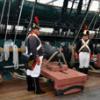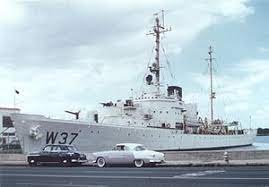-
Posts
1,934 -
Joined
-
Last visited
Content Type
Profiles
Forums
Gallery
Events
Everything posted by popeye2sea
-

How metal hooks are stropped onto block
popeye2sea replied to glennb17's topic in Metal Work, Soldering and Metal Fittings
I think there would be two ways to do this, depending on if you were going to be using a metal grommet or not. If using a metal grommet the hooks eye would have to have been formed around the grommet and then the strop of the block would be spliced to fit around the grommet and the block with the seizing then put on between the grommet and the block. If no grommet was to be employed then the strop would be put through the eye of the hook before being spliced together. Then the seizing is put on in order to form the becket (eye). When blocks were stropped with hooks the usual method was to use a grommet in the becket to reduce friction on the rope by the hook. Regards, -
Yes, For all lower sails, the blocks for the sheet, tack, and clew lines would be attached to the lower corner of the sail when the sail is set. For your knowledge base, the clew is the line that comes down from the yard and is used to haul the corner of the sail up when furling. The sheet is the line that leads aft from the lower corner of the sail and the tack is the line that leads forward from the corner. One method of rigging these three lines on a model when there is no sail bent is to put the strops of the blocks through each other and then hoist them up part way to the yard with the clew. This is not necessarily what would have been done on an actual ship, but it has become something of a conventional usage on models because it does depict what the lines are used for. Regards,
-
I think, in general, a ship is a ship in any country or Navy. There is a very definite evolution in rigging practices throughout the age of sail, but for the most part within any given era most countries were doing the same things. If a change worked for one it was pretty much appropriated by all. The functions of any particular spar or line were the same for all ships. That is why a trained sailor could be employed anywhere, for any country. There were minor differences in the peculiar shape of things or the ratios of sizes. In fact, there were differences from one naval architect, or shipwright, to another. You would even find differences from one sailing master to the next on the same ship. Or one captain to the next. That was the process of innovation. If what you tried worked well enough it would be incorporated into the next vessel. Regards,
- 2,695 replies
-
- heller
- soleil royal
-
(and 9 more)
Tagged with:
-

Blocks and belaying pins and handedness
popeye2sea replied to Srenner's topic in Masting, rigging and sails
You never know what your going to get for rigging plans for these smaller vessels. It is possible that they used blocks vs. dead eyes. Jolie Brise is a pilot cutter, yes? Regards, -

Blocks and belaying pins and handedness
popeye2sea replied to Srenner's topic in Masting, rigging and sails
Two things I see here. First, you are reeving your blocks upside down. The throat of the blocks, or hole that the line goes through should be at the furthest extremes from each other. You have them upside down in their strops. Fixing this should help your blocks stay straighter. Second, for the forward most shroud, simply reeve the tackle so that the working end comes out of the sheave on the same side as the belaying pin. That will eliminate the crossing effect. Hope that helps. Regards, -

Jib Topsail downhaul / tack - running and attaching
popeye2sea replied to juhu's topic in Masting, rigging and sails
I was under the impression that the tack was a fixed length and was not led through a pulley but seized to either the stay or the jib boom at the point where they met. Once you haul the sail up it will only go as high as the tack allows and there should be no need to then have to haul down on the tack. Regards, -

Real knots verses what is practical for scale ships
popeye2sea replied to Srenner's topic in Masting, rigging and sails
Fair enough. But in my case I am not so much trying to make a point, rather I am proving to myself that I can accomplish the goal of doing it the real way. Besides, as far as adding years to the build goes, when you already have 40 years and counting on a build, what's a few more? 😲 Regards, -

Real knots verses what is practical for scale ships
popeye2sea replied to Srenner's topic in Masting, rigging and sails
1:100 -

Real knots verses what is practical for scale ships
popeye2sea replied to Srenner's topic in Masting, rigging and sails
I am one of those crazy few who try and make each rope fastening the way it really is. I tie everything from whippings and seizings to doubled wall and crown knots for my tacks and matthew walker knots for my laniards. I do all the appropriate bends and hitches and splices where needed. I even do rose lashings. But beware, all the above takes a special kind of crazy to do at scale😉 Regards, -

Best Way to Tighten Loose Ratlines
popeye2sea replied to Glomar's topic in Masting, rigging and sails
I know this may not translate well without a diagram, but if you notice when tying a clove hitch one end exits above or below the starting end depending on which way you cross the bight. If you alternate the way you tie each clove hitch such that between each shroud the lead of the clove hitches are top to top or bottom to bottom you my be able to avoid the tendency of forming that sine wave shape between the shrouds. Regards, -
There is really no such thing as the "right" guns for Constitution. They were changed out fairly frequently over her career. The ships guns were not considered to be permanent property of the ship, so to speak. They were loaded aboard for the duration of a cruise and were often off loaded when the ship came back from the cruise when the ship would undergo maintenance. The cannons would then be employed wherever the Navy needed them ashore or on other vessels. When the ship first made ready for sea, 22 July 1798, she had an armament of thirty, iron, 24-pounders from Furnace Hope, in Pennsylvania, sixteen 18-pounders borrowed from Fort Independence on Castle Island, and fourteen 12-pounders of unknown origin (probably Furnace Hope). Constitution must have had a few brass 24's at some point because a letter from the Secretary of the Navy in 1807 ordered the transfer of two brass 24-pounders to USS Wasp. 32-pounder carronades first replaced long guns on the spar deck after the Tripoli campaign in 1804 where they were mounted in the waist. Four of the carronades were transferred to USS Hornet in 1807 and the remaining four were mounted in pairs on the quarter deck and forecastle. The 1812 spar deck battery of carronades consisted of sixteen 32-pounders on the quarterdeck and six 32-pounders on the forecastle. Constitution's armament changed many times until 1900 when she had none at all. In 1834 she had twenty two 24 pounder long guns, twenty 32-pounder carronades and two Congreve 24 pounders. In 1842 the ship received four 68-pounder Paixhans guns mounted in pairs in midship ports on the gun deck, replacing four 24-pounders. In 1847 she mounted twenty six 36-pounder long guns and four 8-inch Paixhans guns on the gun deck and twenty 32 pounder long guns on the spar deck. For the 1907 restoration she had 24 pounder long guns throughout. Because of limited funding and no precise research the design of these guns was based on data found in an eighteeth century book on ordinance, Theodore Roosevelt's The Naval War of 1812, and Louis de Toussard's American Artillerists Companion. In 1927 the spar deck long guns were again replaced with carronades. This restoration also saw the entire battery of guns re-cast for the ship. While far better representations than the 1907 castings they were still not completely accurate to the War of 1812. These are the current weapons on board and they all carry the King George III monogram. Since then, Navy Department files have been discovered which contain a drawing detailing the actual guns the ship carried early on. Regards,
-
The first method shown is called a gasket coil and would not be employed on a belaying pin where the coil needs to be able to be cast loose quickly. The gasket coil, as the name implies, is used to coil up and secure the sail gaskets when not in use. The coil is designed to allow the coil to be suspended from it's standing part. The belaying coil (I don't know the name) hangs the coil from the pin or cleat and can be readily cast off. Regards,
-
It has been my understanding that another name for right hand laid rope is hawser laid. Three hawser laid ropes twisted up left handed into cable laid rope. So named for it's usual usage for anchor cable. Shroud laid rope is four strand or three strand around a central heart. So named for its common use as shrouds. Regards,
-
RC Anderson, The Rigging of Ships in the Days of the Spritsail Topmast 1600-1720: page 94 - 95
-
It is not just the starting point, or the reeving direction that is important. When using cable laid (left hand lay) rope the upper deadeye is turned in by passing the end under the deadeye from right to left as one looks at it from outboard. Then the end crosses behind the standing part and comes up on the right side of it. With right hand laid rope the end goes from left to right under the deadeye and comes up on the left side of the standing part. The end result is that with cable laid rope the ends lie forward on the starboard side and aft on the port. With right hand laid rope the opposite is the case. The laniard always starts from the hole furthest from the end of the shroud. Regards,
-

Attn: ALL LINDBERG Model fans! (Test your knowledge?)
popeye2sea replied to BoSmith_12's topic in Plastic model kits
-
Reseting the steeve of the bow sprit should not be a problem. The complication is getting the doubling for the spritsail topmast back to vertical afterwards. Regards,
- 2,695 replies
-
- heller
- soleil royal
-
(and 9 more)
Tagged with:
-
The standing end of the top rope would be seized to an eyebolt under the cap, opposite the block. You are also correct that the top rope would only be rigged when raising or lowering the top mast. BTW, in the second photo, the second image makes no sense at all. If you just consider the first and third images you have it right. Regards,
-

Cutty Sark(Revell 1:96) rigging confusion
popeye2sea replied to Terry Foster's topic in Masting, rigging and sails
As far as I can tell, the inset is more correct. Line 92 is the inhaul for sail 10, attached to the top corner of the sail through the block at the base of the gaff and down to the pin rail aft of the mast. Line 94 is the down haul for sail 8, attached to the lower forward corner of sail through one of the blocks at the mast cap, down through the top platform on the port side and belay to the pin rail forward of the mast. Line 95 is the peak halyard for the gaff of sail 10, attached to the end of the gaff through the other block at the mast cap then down through the top platform and belay to the pin rail forward of the mast. Line 96 is the downhaul for sail 9, attached to the lower forward corner of sail 9 then through the block at the back edge of the top platform then down to the pin rail forward of the mast. Line 109 is the sheet for sail 10, attached to the lower aft corner of sail 10 and then belay directly to the pin rail on the port side. Perhaps for this line the diagram is calling for you to lead line 109 through both lower corners of the sail 10, the forward part through the block at the lower forward corner of the sail and then to pin 92, but this part does not make much sense to me. I hope that helps. Regards, -
Kev, At the risk of answering the wrong question, The line that runs from the mast head to the bowsprit is call the fore stay (this is the line I mentioned to you in your other thread). For the shrouds, the top deadeye gets two and sometimes three seizings around the shroud. The first is called a throat seizing and it goes where the two parts of the shroud cross above the dead eye. The second is called the middle seizing and it is a round seizing. The third is called the end seizing also of the round seizing type, and comes at or near the end of the shroud. The very end of the shroud would also be whipped to prevent unlaying. The stay, where it comes down to the bowsprit will be attached in some fashion to a collar that is seized around the bowsprit with either a heart, a deadeye, or a block seized in. The lower end of the stay will have the corresponding heart etc. seized in. A laniard will be passed between the two fittings to set up (tension) the stay. Depending on which fitting you use will determine the type and number of seizings required. If you use a dead eye it will be seized in in the same manner as the shrouds. A heart or a block would probably only have two seizings. A lot of terminology, I know, but it will become familiar soon enough. Regards,
-
The instructions did not call for that. I used it the way it was. That model foundered in a storm (the infamous cleaning whirlwind of '79) and was lost with all hands, and I have no pictorial evidence to show you how the rigging looked. Regards,
-

Standing Rigging, port or starboard first?
popeye2sea replied to Peanut6's topic in Masting, rigging and sails
The traditional method is to start on the starboard side. Then alternate port and starboard pairs. In fairness, I can't see how starting on one side or the other has any advantage. The important thing is to start with the forward most pair and proceed aft. The stay, which is what I think you are referring to as the bowsprit shroud?, would be the last to be fitted over the mast head. Regards, -
I still have some of that thread from my Cutty Sark kit from back in the day. It is definitely what came with the kit. And those are the original spools. As far as I recall, it was always that color. Regards,
About us
Modelshipworld - Advancing Ship Modeling through Research
SSL Secured
Your security is important for us so this Website is SSL-Secured
NRG Mailing Address
Nautical Research Guild
237 South Lincoln Street
Westmont IL, 60559-1917
Model Ship World ® and the MSW logo are Registered Trademarks, and belong to the Nautical Research Guild (United States Patent and Trademark Office: No. 6,929,264 & No. 6,929,274, registered Dec. 20, 2022)
Helpful Links
About the NRG
If you enjoy building ship models that are historically accurate as well as beautiful, then The Nautical Research Guild (NRG) is just right for you.
The Guild is a non-profit educational organization whose mission is to “Advance Ship Modeling Through Research”. We provide support to our members in their efforts to raise the quality of their model ships.
The Nautical Research Guild has published our world-renowned quarterly magazine, The Nautical Research Journal, since 1955. The pages of the Journal are full of articles by accomplished ship modelers who show you how they create those exquisite details on their models, and by maritime historians who show you the correct details to build. The Journal is available in both print and digital editions. Go to the NRG web site (www.thenrg.org) to download a complimentary digital copy of the Journal. The NRG also publishes plan sets, books and compilations of back issues of the Journal and the former Ships in Scale and Model Ship Builder magazines.






